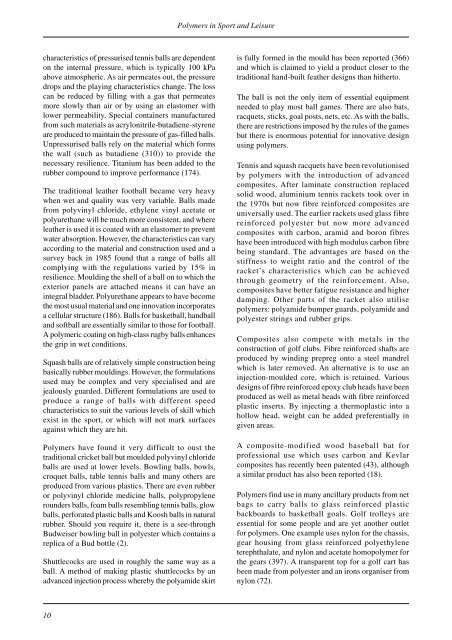Polymers in Sport and Leisure
Polymers in Sport and Leisure
Polymers in Sport and Leisure
You also want an ePaper? Increase the reach of your titles
YUMPU automatically turns print PDFs into web optimized ePapers that Google loves.
<strong>Polymers</strong> <strong>in</strong> <strong>Sport</strong> <strong>and</strong> <strong>Leisure</strong><br />
characteristics of pressurised tennis balls are dependent<br />
on the <strong>in</strong>ternal pressure, which is typically 100 kPa<br />
above atmospheric. As air permeates out, the pressure<br />
drops <strong>and</strong> the play<strong>in</strong>g characteristics change. The loss<br />
can be reduced by fill<strong>in</strong>g with a gas that permeates<br />
more slowly than air or by us<strong>in</strong>g an elastomer with<br />
lower permeability. Special conta<strong>in</strong>ers manufactured<br />
from such materials as acrylonitrile-butadiene-styrene<br />
are produced to ma<strong>in</strong>ta<strong>in</strong> the pressure of gas-filled balls.<br />
Unpressurised balls rely on the material which forms<br />
the wall (such as butadiene (310)) to provide the<br />
necessary resilience. Titanium has been added to the<br />
rubber compound to improve performance (174).<br />
The traditional leather football became very heavy<br />
when wet <strong>and</strong> quality was very variable. Balls made<br />
from polyv<strong>in</strong>yl chloride, ethylene v<strong>in</strong>yl acetate or<br />
polyurethane will be much more consistent, <strong>and</strong> where<br />
leather is used it is coated with an elastomer to prevent<br />
water absorption. However, the characteristics can vary<br />
accord<strong>in</strong>g to the material <strong>and</strong> construction used <strong>and</strong> a<br />
survey back <strong>in</strong> 1985 found that a range of balls all<br />
comply<strong>in</strong>g with the regulations varied by 15% <strong>in</strong><br />
resilience. Mould<strong>in</strong>g the shell of a ball on to which the<br />
exterior panels are attached means it can have an<br />
<strong>in</strong>tegral bladder. Polyurethane appears to have become<br />
the most usual material <strong>and</strong> one <strong>in</strong>novation <strong>in</strong>corporates<br />
a cellular structure (186). Balls for basketball, h<strong>and</strong>ball<br />
<strong>and</strong> softball are essentially similar to those for football.<br />
A polymeric coat<strong>in</strong>g on high-class rugby balls enhances<br />
the grip <strong>in</strong> wet conditions.<br />
Squash balls are of relatively simple construction be<strong>in</strong>g<br />
basically rubber mould<strong>in</strong>gs. However, the formulations<br />
used may be complex <strong>and</strong> very specialised <strong>and</strong> are<br />
jealously guarded. Different formulations are used to<br />
produce a range of balls with different speed<br />
characteristics to suit the various levels of skill which<br />
exist <strong>in</strong> the sport, or which will not mark surfaces<br />
aga<strong>in</strong>st which they are hit.<br />
<strong>Polymers</strong> have found it very difficult to oust the<br />
traditional cricket ball but moulded polyv<strong>in</strong>yl chloride<br />
balls are used at lower levels. Bowl<strong>in</strong>g balls, bowls,<br />
croquet balls, table tennis balls <strong>and</strong> many others are<br />
produced from various plastics. There are even rubber<br />
or polyv<strong>in</strong>yl chloride medic<strong>in</strong>e balls, polypropylene<br />
rounders balls, foam balls resembl<strong>in</strong>g tennis balls, glow<br />
balls, perforated plastic balls <strong>and</strong> Koosh balls <strong>in</strong> natural<br />
rubber. Should you require it, there is a see-through<br />
Budweiser bowl<strong>in</strong>g ball <strong>in</strong> polyester which conta<strong>in</strong>s a<br />
replica of a Bud bottle (2).<br />
Shuttlecocks are used <strong>in</strong> roughly the same way as a<br />
ball. A method of mak<strong>in</strong>g plastic shuttlecocks by an<br />
advanced <strong>in</strong>jection process whereby the polyamide skirt<br />
is fully formed <strong>in</strong> the mould has been reported (366)<br />
<strong>and</strong> which is claimed to yield a product closer to the<br />
traditional h<strong>and</strong>-built feather designs than hitherto.<br />
The ball is not the only item of essential equipment<br />
needed to play most ball games. There are also bats,<br />
racquets, sticks, goal posts, nets, etc. As with the balls,<br />
there are restrictions imposed by the rules of the games<br />
but there is enormous potential for <strong>in</strong>novative design<br />
us<strong>in</strong>g polymers.<br />
Tennis <strong>and</strong> squash racquets have been revolutionised<br />
by polymers with the <strong>in</strong>troduction of advanced<br />
composites. After lam<strong>in</strong>ate construction replaced<br />
solid wood, alum<strong>in</strong>ium tennis rackets took over <strong>in</strong><br />
the 1970s but now fibre re<strong>in</strong>forced composites are<br />
universally used. The earlier rackets used glass fibre<br />
re<strong>in</strong>forced polyester but now more advanced<br />
composites with carbon, aramid <strong>and</strong> boron fibres<br />
have been <strong>in</strong>troduced with high modulus carbon fibre<br />
be<strong>in</strong>g st<strong>and</strong>ard. The advantages are based on the<br />
stiffness to weight ratio <strong>and</strong> the control of the<br />
racket’s characteristics which can be achieved<br />
through geometry of the re<strong>in</strong>forcement. Also,<br />
composites have better fatigue resistance <strong>and</strong> higher<br />
damp<strong>in</strong>g. Other parts of the racket also utilise<br />
polymers: polyamide bumper guards, polyamide <strong>and</strong><br />
polyester str<strong>in</strong>gs <strong>and</strong> rubber grips.<br />
Composites also compete with metals <strong>in</strong> the<br />
construction of golf clubs. Fibre re<strong>in</strong>forced shafts are<br />
produced by w<strong>in</strong>d<strong>in</strong>g prepreg onto a steel m<strong>and</strong>rel<br />
which is later removed. An alternative is to use an<br />
<strong>in</strong>jection-moulded core, which is reta<strong>in</strong>ed. Various<br />
designs of fibre re<strong>in</strong>forced epoxy club heads have been<br />
produced as well as metal heads with fibre re<strong>in</strong>forced<br />
plastic <strong>in</strong>serts. By <strong>in</strong>ject<strong>in</strong>g a thermoplastic <strong>in</strong>to a<br />
hollow head, weight can be added preferentially <strong>in</strong><br />
given areas.<br />
A composite-modified wood baseball bat for<br />
professional use which uses carbon <strong>and</strong> Kevlar<br />
composites has recently been patented (43), although<br />
a similar product has also been reported (18).<br />
<strong>Polymers</strong> f<strong>in</strong>d use <strong>in</strong> many ancillary products from net<br />
bags to carry balls to glass re<strong>in</strong>forced plastic<br />
backboards to basketball goals. Golf trolleys are<br />
essential for some people <strong>and</strong> are yet another outlet<br />
for polymers. One example uses nylon for the chassis,<br />
gear hous<strong>in</strong>g from glass re<strong>in</strong>forced polyethylene<br />
terephthalate, <strong>and</strong> nylon <strong>and</strong> acetate homopolymer for<br />
the gears (397). A transparent top for a golf cart has<br />
been made from polyester <strong>and</strong> an irons organiser from<br />
nylon (72).<br />
10










